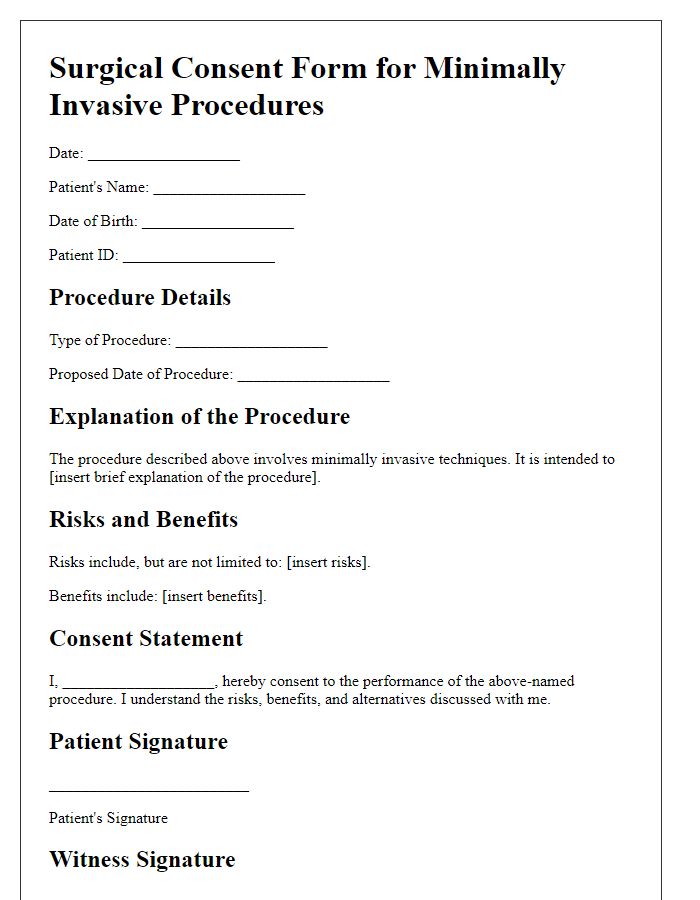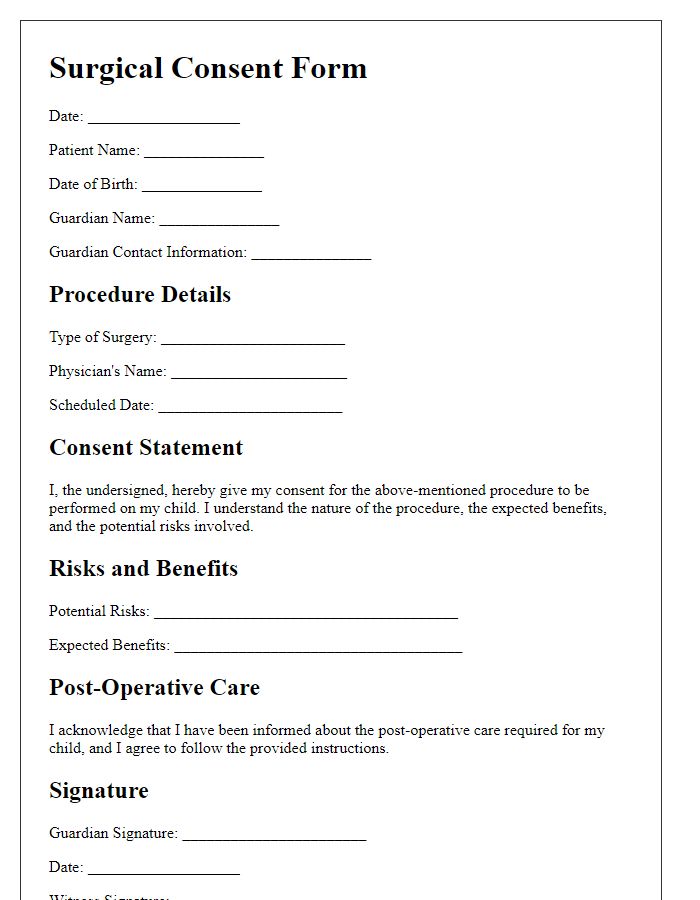When it comes to undergoing a surgical procedure, understanding the importance of a surgical consent form is crucial. This document not only outlines the specifics of the surgery but also ensures that patients are fully aware of the risks and benefits involved. It serves as a protective measure for both the patient and the healthcare provider, reinforcing informed decision-making in the medical field. Curious to learn more about what a surgical consent form entails and why it's essential? Read on!

Patient Identification
Patient identification in surgical consent forms is a critical process ensuring accuracy and safety in medical procedures. Details include full name, date of birth, and unique identification number, often linked to electronic health records for verification. The patient's address and contact information provide additional context. Specific identifiers such as Social Security number and insurance information may be requested for administrative purposes. Emotional readiness and understanding of the procedure should also be noted, highlighting the significance of informed consent in surgical practices. Ensuring accurate patient identification minimizes the risk of errors, enhancing the overall safety of surgical interventions.
Procedure Description
Surgical consent forms outline essential details regarding specific medical procedures, ensuring patient understanding and compliance. The procedure description should include the full name of the surgical operation, such as laparoscopic cholecystectomy (removal of the gallbladder). It is important to specify the indications for surgery, including symptomatic gallstones or cholecystitis. An explanation of the surgical technique, whether performed using minimally invasive methods with small incisions or open surgery, must be included. Potential risks and benefits of the procedure should also be clearly articulated, along with possible complications such as infection (which occurs in approximately 1-3% of cases) and bleeding. Additionally, the anticipated recovery timeline, generally ranging from one to two weeks for minimally invasive procedures, should be outlined to provide the patient with an understanding of post-operative expectations. Finally, it is critical to incorporate details regarding anesthesia, typically general anesthesia, and the involvement of the surgical team comprising board-certified surgeons and anesthesiologists.
Risks and Benefits
Surgical consent forms outline the essential information regarding the procedure to be conducted, detailing both risks and benefits to ensure the patient is fully informed. Common risks associated with surgical procedures, such as infection, bleeding, and complications related to anesthesia, vary significantly depending on the type of surgery--ranging from simple outpatient surgeries to complex operations requiring hospitalization. In contrast, the benefits of undergoing surgery, including pain relief, improved function, and enhanced quality of life, play a critical role in the decision-making process. Understanding the specific context of the surgical intervention, such as the condition being treated--like appendicitis or joint replacement--and the typical recovery timeline, can help patients weigh their options more effectively. Comprehensive discussions with healthcare providers, surgeons specializing in the relevant field, and consideration of alternative treatments are crucial components of the informed consent process prior to any surgical procedure.
Alternative Options
Informed consent is a critical process in surgical procedures, as it involves patients understanding potential risks, benefits, and alternative treatment options. Patients exploring alternative options, such as lifestyle changes, dietary adjustments, physical therapy, or non-invasive treatments, should be provided with comprehensive information. Research studies suggest that some non-surgical methods, particularly physical therapy, can effectively manage conditions requiring surgery, like knee osteoarthritis, with success rates up to 60%. Additionally, holistic approaches, including acupuncture and chiropractic care, offer pain relief for various musculoskeletal issues. Moreover, patients should be informed about natural remedies, such as herbal supplements, emphasizing the importance of discussing these alternatives with healthcare providers to assess their suitability. Each alternative presents unique considerations for efficacy and safety, underscoring the importance of an informed decision-making process.
Consent Confirmation
Surgical consent forms serve as critical legal documents ensuring that patients, or their authorized representatives, provide informed consent before undergoing surgery. These forms typically outline specific details about the procedure, risks, benefits, and alternatives. Patients should be informed of their rights, including the right to ask questions about their treatment options, particularly for procedures like laparoscopic cholecystectomy or knee arthroscopy. Consent confirmations should also clarify potential complications such as infection or anesthesia-related risks, which can differ based on individual health factors. Accurate documentation of consent is essential for compliance with healthcare regulations and safeguarding the rights of patients.
Letter Template For Surgical Consent Form Samples
Letter template of surgical consent form for minimally invasive procedures













Comments